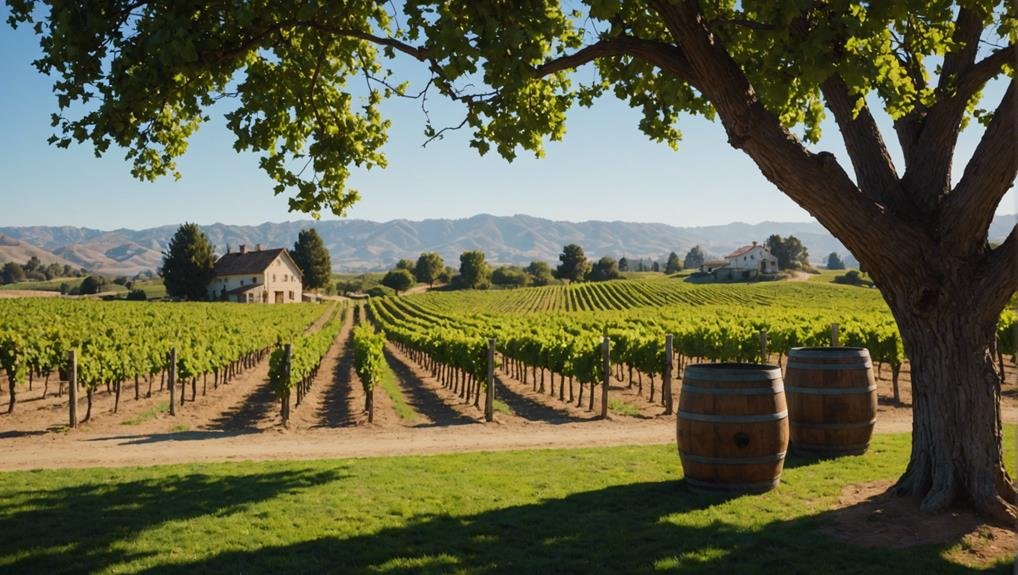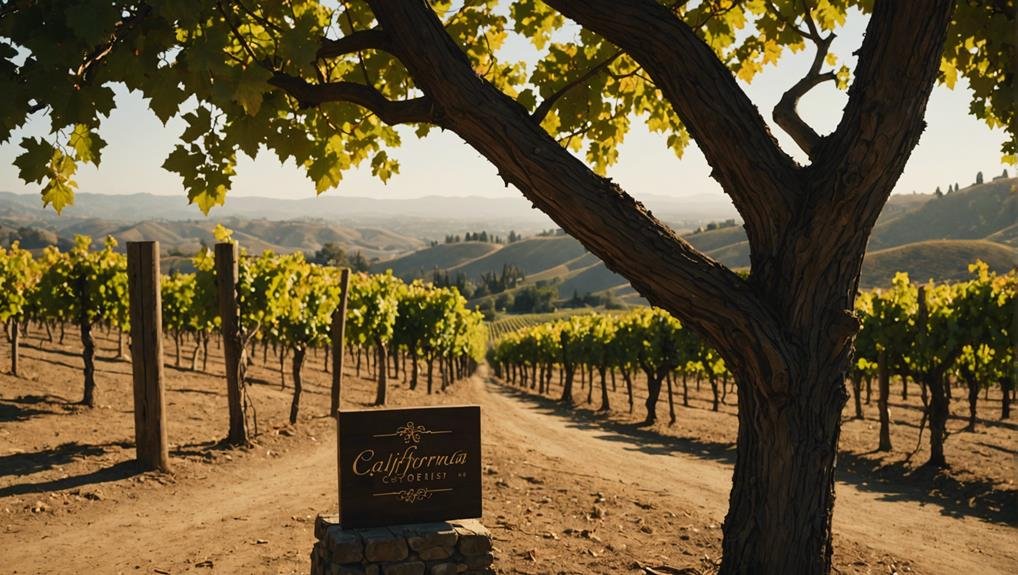We've uncovered California's rich vineyard history, tracing back to heritage vines in Napa and Sonoma. This exploration, influenced by Dr. Austin Goheen's work, revealed disease-resistant and flavor-enhancing grape cuttings, such as Cabernet Sauvignon Clone 6 and Sauvignon Blanc Clone 29.
These findings have significantly shaped modern viticulture, improving wine quality and diversity. The Jackson Station Vineyard was pivotal, introducing grape strains that still thrive today.
California's wine industry owes much to these historical treasures, and there's more to discover about their ongoing impact.
Historical Significance of Wine
Wine is more than just a drink; it's a reflection of our history and culture. Tracing its origins takes us back thousands of years, from the early vineyards of Mesopotamia to the advanced wine-making techniques of Ancient Rome. These ancient practices influenced rituals, trade, and social structures. Exploring the history of wine reveals its deep connection to human civilization.
Wine has been part of celebrations, religious ceremonies, and everyday meals, linking us to our ancestors. Each bottle tells a story, preserving a piece of our past.
For example, Mesopotamians were among the first to cultivate grapes and produce wine around 6,000 BC. In Ancient Rome, wine was a staple of daily life and commerce, with sophisticated methods like aging wine in wooden barrels. These historical practices not only created a popular beverage but also shaped social customs and economic systems.
Wine's enduring presence in our lives, from special occasions to simple dinners, keeps us connected to these rich traditions.
Discovery of Heritage Vines
Discovering the history of heritage vines in California started with Fred Peterson's intriguing story about the mysterious Petit Verdot. This led us to explore long-standing viticultural puzzles. We found forgotten treasures in Napa and Sonoma, tracing their roots back to a lost experimental vineyard. Dr. Austin Goheen's dedication to finding quality grapevine cuttings uncovered these secrets.
In Amador County, an abandoned vineyard revealed its grapevine origins, offering insight into the past. These heritage vines, once ignored, are now a key part of California's wine industry.
Jackson Station Vineyard History

The Jackson Station Vineyard has a fascinating history that starts with the Foothill Experiment Station. This station was originally set up to help miners transition into farming. It was meant to be a leading example of agricultural progress. Unfortunately, by 1903, it was abandoned due to high operational costs.
Legal disputes with squatters made things worse, leading to conflict and unrest. Eventually, the property was raided and burned, forcing its closure.
Years later, Dr. Austin Goheen rediscovered the vineyard. His efforts highlighted its historical value, and he managed to obtain valuable plant cuttings from it.
- High Costs: The station was too expensive to run.
- Squatter Disputes: Legal issues with squatters caused problems.
- Destruction: Conflict led to the property being raided and burned.
- Rediscovery: Dr. Goheen brought attention to its history and secured important cuttings.
Dr. Goheen's work is crucial because it preserved a piece of agricultural history that might've been lost forever.
Impact of Jackson Station Cuttings
Dr. Goheen's rediscovery of the Jackson Station cuttings changed California's wine industry by introducing disease-resistant strains that improved Napa and Sonoma wines. The Cabernet Sauvignon Clone 6 and Sauvignon Blanc Clone 29 were particularly impactful.
Clone 6 is known for producing rich, intense Cabernet grapes, enhancing the flavor and depth of the wine. Clone 29, used in Robert Mondavi's Fumé Blanc, showed excellent disease resistance, leading to healthier vines and more reliable yields.
Legacy of Heritage Vines

Heritage vines from Jackson Station have left a lasting mark on California's wine industry, shaping its future with their unique traits and resilience. These vines, with their rich grapevine heritage, have spurred innovations in viticulture throughout the state. Sharing these cuttings has ensured that this legacy continues to thrive in modern vineyards.
- Cabernet Sauvignon Clone 6: Known for its rich, intense flavors, it's a cornerstone in Napa vineyards.
- Sauvignon Blanc Clone 29: Used prominently in Robert Mondavi's Fumé Blanc, it's famed for its distinct qualities.
- Petit Verdot Clone 2: Provides deep color and strong yields, improving many blends.
- Viticulture Innovations: These heritage vines have led to advancements in disease resistance and grape quality.
Understanding this legacy helps us better appreciate California wines. For instance, enjoying a glass of Robert Mondavi's Fumé Blanc or a rich Napa Cabernet Sauvignon can give you a taste of this history.
Conclusion
As we conclude our exploration of California's wine country, it's evident that heritage vines are essential to the industry. These old vines, similar to the roots of an ancient tree, provide a foundation of history and strength.
Thanks to Dr. Goheen's groundbreaking work and the lasting significance of Jackson Station cuttings, these vines have helped shape the wines we enjoy today.
Understanding this legacy enriches our appreciation for each glass of wine. For instance, the Zinfandel from Ridge Vineyards and the Cabernet Sauvignon from Napa's Stag's Leap Wine Cellars are perfect examples of wines rooted in this rich history.
By recognizing the importance of these heritage vines, we can better anticipate the future of California winemaking. This appreciation not only enhances our enjoyment but also supports the ongoing efforts to preserve and innovate in the industry.